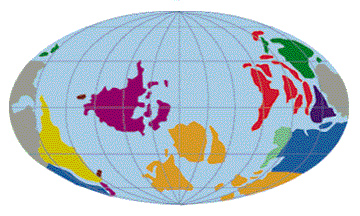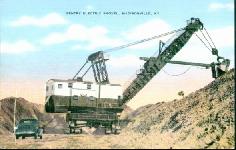Click on image for full size
Image from: Kentucky Coal Education Web Site
Iron Ore Deposits
Eventually, as with the development of photosynthesis along sulfur and methane pathways, where sulfur and methane products are produced, photosynthesis along the
oxygen pathway, where oxygen is produced, came into being.
One important thing to know about oxygen is that it is very reactive. It is one of the most reactive of all the elements in nature. This means that it will readily attack and attach itself to other elements. In particular, iron, sulfur, and manganese are readily attacked by oxygen.
As molecular oxygen began to be produced by early autotrophs, a curious phenomena occured. Large amounts of iron which had accumulated in the early ocean as both FeSO4- and a solid FeS2 (pyrite) from naturally occuring weathering and as a product of heterotrophic activity, were attacked by the accumulating O2. As O2 reacts with FeS2 (pyrite), Fe2O3 (limonite) is produced. When O2 reacts with FeSO4-, Fe2O3 (hematite) is produced. These rocks, along with magnetite (Fe3O4 - a magnetic rock) and siderite (FeCO3), are also called iron ores. Oxide rocks such as these are mined today, and the iron (Fe) they contain is extracted.
Over a period of a billion years, huge deposits of iron ores were laid at the bottom of the sea. This activity took place between 3.5 and 2.5 billion years ago. Iron ores mined today in the United States, Australia, and South Africa, are part of the huge deposits laid down at that time. Once the oceans were swept clean of iron, then the oxygen could begin to accumulate in the atmosphere, and respiration
by sophisticated life forms could begin in earnest. It took a billion years for this process to complete. When it was finished, it closed the period in the history of the Earth which we call the Archean
.
You might also be interested in:

Photosynthesis is the name of the process by which autotrophs (self-feeders) convert water, carbon dioxide, and solar energy into sugars and oxygen. It is a complex chemical process by which plants and
...more
An element (also called a "chemical element") is a substance made up entirely of atoms having the same atomic number; that is, all of the atoms have the same number of protons. Hydrogen, helium, oxygen,
...more
Organisms that are able to make their own food (in the form of sugars) by using the energy of the Sun are called autotrophs, meaning "self-feeders". Photosynthesis is the name of the process through which
...more
We all know that salt is a big part of the ocean water today. Two things help scientists figure out what chemicals may have been part of the Earth's early oceans. Igneous rocks are made of iron, aluminum,
...more
The first beings were probably much like coacervates. As a group, these bacteria are called heterotrophic anaerobes. Because there was virtually no oxygen in the atmosphere at this time, these bacteria
...more
Respiration is the name of the general process by which living organisms convert sugars and oxygen into biochemical energy. The process occurs in all organisms, including animals, plants, fungi, and bacteria
...more
About 2.5 billion years ago (BYA), after the iron in the ocean was gone to form iron ore deposits, oxygen began accumulating in the atmosphere. Soon, enough oxygen accumulated in the early atmosphere for
...more
The Archean is the name of the age which began with the forming Earth. The duration of the Archean, 2.8 billion years, is more than half the expected age of the Earth. We don't know much about this period,
...more














